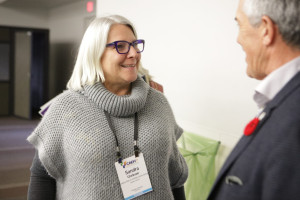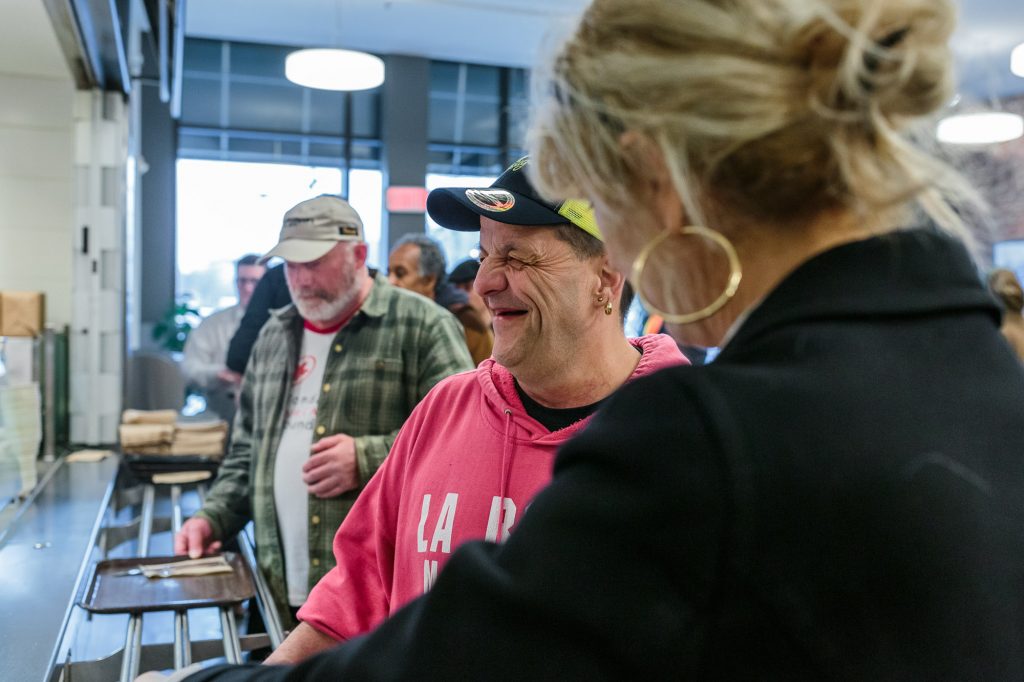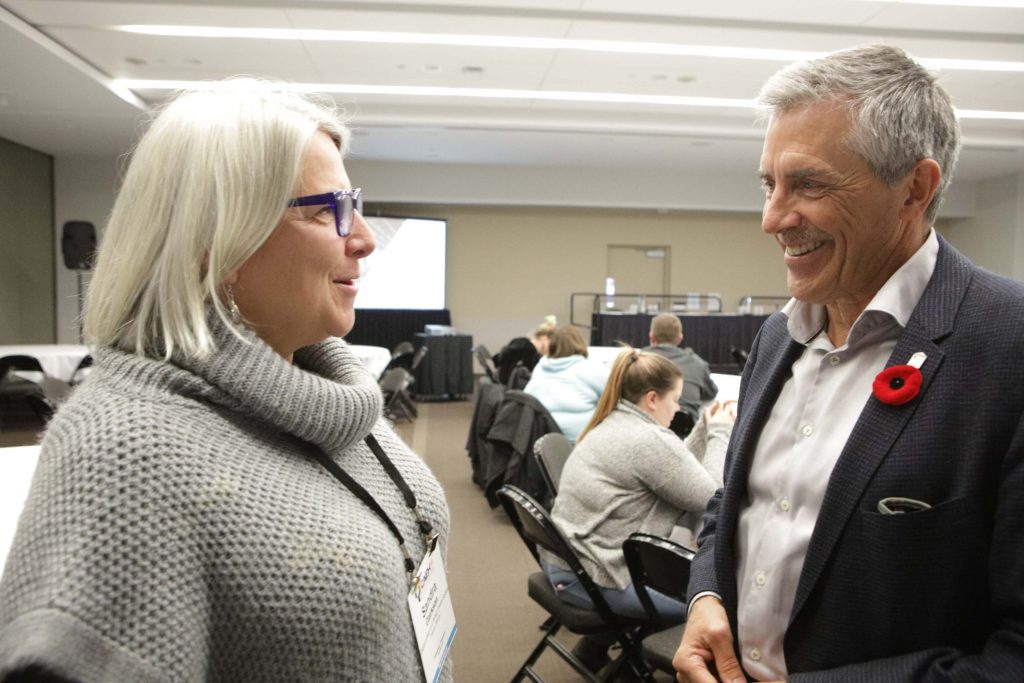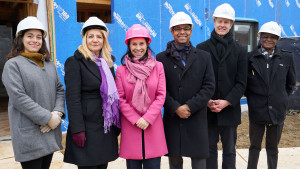
Inspiring Change: How Shelters Can Learn and Work Together

Evolving from Soup Kitchens to Housing-Focused
When Sandra Clarkson, the Executive Director at the Calgary Drop-In and Rehab Centre (DI) first learned about the Old Brewery Mission two years ago, little did she realize that she’d team up with Matthew Pearce, Mission CEO, to invoke major change in the shelter world. It was at a book signing in Calgary for the launch of Beyond Shelters: Solutions to Homelessness in Canada from the front Lines (Lorimer 2018) that the book’s editor and co-author, James Hughes, suggested she speak with Matthew about the Mission’s transformative process from soup kitchen to housing-focused organization.
Since then, these two leaders talk regularly on the phone to share best practices, discuss challenges and test new ideas. The two were adamant that shelters needed to evolve, to go beyond providing a bed for the evening to addressing the issues that lead to housing instability or homelessness.
“Fundamentally, it’s about recognizing and acknowledging that we, shelters, were directly contributing to chronic homelessness. Merely providing life’s basic necessities—food, shelter, clothing—doesn’t address a person’s barriers to housing and it doesn’t provide opportunities for them to regain independence,” states Sandra.

The Shift to Housing First
She notes that, in the past, the DI had instituted a number of well-intentioned programs, like art and music. However, these were ineffective in helping people get off the street. As well, certain protocols, like mandating clients to volunteer in the centre in order to access permanent shelter beds, were not directed at putting an end to chronic homelessness. Her conversations with Matthew had reinforced her view that the centre needed to emphasize Housing First programs.
Sandra convinced the DI’s board of directors to make some tough choices, like getting rid of certain programs. Clients were no longer required to volunteer. Spaces, like the library, were converted into housing focused areas. The DI also increased its number of access points to get people connected to housing. The centre set up a “small but mighty” case management team for people with more complex issues like mental health or addiction. Those tough decisions paid off. “At one point, we could count over 400 people who had been living in the shelter for years. In two years, we reduced the DI’s chronic homeless population by 45%.”
“Creativity is important if we’re to innovate. That’s why, at the DI, we created two housing-focused teams: case management and diversion. The case management team works with these long-term shelter clients to find appropriate housing in the community and the diversion team focuses on new shelter clients to determine what brought them to us and how to get them reconnected to community as quickly as possible.”
When asked what enabled the DI to make these changes possible, she points to a one-time grant from The Calgary Homeless Foundation. Sandra acknowledges that removing financial barriers is key to meaningful, sustainable change. While outcomes have slowed since the funding ran out, she says that the DI remains wholly committed to shifting from emergency to housing.

The Challenges of Change
The shift towards a Housing First approach was a challenge at first as some of the staff were entrenched in traditional ways of doing things.
“When we started to make the transition, some long-term employees were not super keen. We invested time with front-line staff to explain that our job is more than meeting people’s basic needs. Our job is to reignite a desire in our clients to want something better for themselves; to help them realize the possibility of having their own home. We needed to break out of an institutionalized way of thinking,” Sandra explains.
“It’s unintentional, but sometimes, it’s easy for organizations to think more about the agency than the client. When using a client-centred approach to homelessness, the goal is to put an end to it, effectively putting yourself out of business. People say that, but they don’t really mean it,” says Sandra. “This is something we have in common with the Old Brewery Mission: we’re aligned philosophically. The Mission is further along, so I look to them to see what they’re doing, to see what’s on the horizon,” she adds.
For his part, Matthew is happy to share strategies for overcoming barriers to transforming from emergency to housing services.
“These conversations benefit the Mission and the greater shelter community,” says Matthew. “To see the end of homelessness, whether it is in Montreal, Calgary or anywhere else, we need to not only think differently, but act collectively. This means sharing data, learning from one another and working together to create effective strategies and secure funding.”
Sandra recognizes the importance of good data and says the DI is in the midst of an IT transformation. “As much as we can, we use data to inform our programs and this is something Matthew and I discuss a lot.”

The Mission as a Model
Sandra points to the Mission’s commitment towards housing and community outreach as a source of inspiration. “I’d like to be able to say that, like the Old Brewery Mission, our emergency shelter is no longer the largest piece of the operations and that we have optimized shelter as a result,” she says.
Opened nearly 60 years ago—the Mission 130 years ago—the DI is a 24/7 operation that now has the largest number of shelter spaces of any emergency shelter in North America. “But that’s not something we brag about,” Sandra says. “Like the Mission, we want to reduce shelter numbers, reduce the length of stay, increase our housing stock and effectively get people back into the community in their own homes as quickly as possible.”
More recently, the DI has also been working with Iain De Jong, President and CEO of OrgCode, an organization with expertise in homelessness, human services data, planning and policy, to help optimize the centre’s shelter space and shift towards becoming housing focused.
“I first heard him give a talk at the Canadian Alliance to End Homelessness conference in Winnipeg, about optimizing shelters. I thought to myself, ‘What have we been doing all this time?’ We have to do this!’ When I became DI’s Executive Director in 2018, we had Iain come to spend a week with us at the Centre. With Iain’s help, we’ve shifted how we provide services. We converted a wing of one of the DI’s floors, which was populated by shelter beds, into a home-care space.” states Sandra.
“I know the Mission has beds dedicated to mental health programs and it’s something we really want to look into,” she continues. “We have big ideas which are also doable. The Mission is doing it: enhancing health and wellness services, working with the public health system and providing these services where clients are at.”
Sandra believes that creating a strong sense of community, using a model based on social diversity and inclusion, where client choice is of the utmost importance, makes all the difference. Like the Mission, she believes in a tailored approach, where counsellors work with each individual to get them off the streets.

Living Up to Corporate Standards
Sandra notes that organizations like the Old Brewery Mission and the DI operate at a level of sophistication never before seen in the sector. They are also held up to higher, unrealistic standards compared to the private sector. “We must be much more agile and nimble and operate under challenging constraints with restricted funding, just to keep the lights on.”
She asserts that measuring impact, not administration costs, would be a better indication of whether an organization is worth donating to. “We’re expected to keep administration costs to 10% and below when the private sector operates with overheard costs of 30% or more.”
Like the Mission, Sandra thinks donors and funders see the value in becoming housing focused but says government funding practices have to evolve with the times. She outlines how funding models have been based on head count, or number of beds. When numbers go down, funding gets cut. Sandra acknowledges that this model encourages organizations to stay full and keep reporting high numbers.
She also points out that many front-line workers in homelessness are making minimum wage. “Their responsibilities include assessing a person’s mental and physical health state, as well as counselling and guiding individuals towards appropriate programs and resources in the community. This is anything but entry-level work.”
In addition to the challenges of working within the realities of a non-profit environment, she says we need to change how people see the role of non-profits altogether. “In a society driven by capitalism and profit, being profitable means you’re succeeding. The term ‘non-profit’ automatically pegs us as ‘lesser than.’ I would prefer to use the term ‘social profit’ organization.”

Shifting Attitudes
When asked if she sees attitudes about homelessness changing for the better, she pauses and states: “From a stigma perspective, I still think there’s an ‘us and them’ mentality. Ultimately, once people understand that the root of homelessness is trauma, that might start to shift the narrative.”
“I look forward to the opportunity to work more closely with the Mission, to practice open source sharing, shift the narrative and help pave the way for others to be an engine to ending homelessness. That would be truly phenomenal.”
A Future of Closer Collaboration
Through these ongoing conversations, it has become clear that a movement of individuals, organizations and communities working together to end homelessness is alive across Canada.
Part of this effort is the Canadian Shelter Transformation Network (CSTN), where Sandra and Matthew are co-chairs. The CSTN is a new peer-led initiative dedicated to supporting the transformation of homeless shelters towards a housing focused approach through research, training and peer learning. It is supported by the Canadian Alliance to End Homelessness (CAEH), an organization committed to ending homelessness. In fact, it was the CAEH’s founder, Tim Richter, who asked Sandra and Matthew to take on the roles of co-chairs.
Matthew describes the CSTN as an exciting opportunity to be on the cutting edge of a major change in the shelter world. “Network members are committed to shifting their focus from emergency to housing, have a bias for action and are committed to continuous improvement toward a singular goal: ending chronic homelessness. The CSTN is not a shelter network—it is a transformation network!”
Dernières nouvelles
-
 The Old Brewery Mission Mobile Health Clinic, powered by TELUS Health, celebrates its first birthday
The Old Brewery Mission Mobile Health Clinic, powered by TELUS Health, celebrates its first birthday -
 Meet Mila Alexova, Coordinator of Outreach Services
Meet Mila Alexova, Coordinator of Outreach Services -
 Meet Nicholas Singcaster, psychosocial counsellor at the mobile clinic
Meet Nicholas Singcaster, psychosocial counsellor at the mobile clinic -
 i
iLaurence Lavigne, Mayor of Villeray-Saint-Michel-Parc-Extension, Patricia Lattanzio, MNA for Saint-Léonard-Saint-Michel, Valérie Plante, Mayor of Ville de Montréal, Lionel Carmant, Minister responsible for Social Services, James Hughes, President and CEO of the Old Brewery Mission, and Ernst Weche, Director of the LOGIS-RAP Board of Directors. Photo credit: Ville de Montréal - Sylvain Légaré.
New housing project in Villeray-Saint-Michel-Parc-Extension -
 Report: Resting in the warmth while waiting for a roof
Report: Resting in the warmth while waiting for a roof - See all news